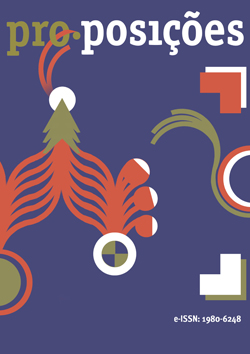Abstract
The text discusses care as the ontological dimension and constitutive power of the human. It is based on a theoretical matrix that links authors from the area of Early Childhood Education with the ontology of Martin Heidegger. It presents the concept of care (sorge) – care/curation in an ontological dimension – of Heidegger, and takes it as an articulating axis from which corporeality and spatiality are thought. The concept of tact, by Helmholtz, is also developed in order to support the notion of contact, brought to the fore by Marta Nörnberg. It ratifies the author's argument that the institutions of early childhood education should be considered domus, that is, common abodes where the status of being-in-the-world-with-things-with-others is favored by means of a careful/curator commitment. Highlighted, even briefly, the importance of the act of playing and the need for a careful/curator look both at the play and at the environments and bodies. Finally, he argues that the institutions of Early Childhood Education should be cares/caregivers environments that propitiate familiarity and contact, indicating the constituent ways of being-in-the-world.
References
Barbosa, M. C. S, & Horn, M. G. S. (2008). Projetos pedagógicos na educação infantil. Porto Alegre: Artmed.
Dalbosco, C. A. (2006). O cuidado como conceito articulador de uma nova relação entre filosofia e pedagogia. Educação e Sociedade, 27(97), 1113-1135.
Debortoli, J. A. et al. (2009). Projeto Brincar: experiências e memórias de brincadeiras na educação básica e na formação de professores. In A. Carvalho, F. Salles, M. Guimarães, & J. A. Debortoli (Orgs.), Brincar(es). Belo Horizonte: UFMG.
Faria, V., & Salles, F. (2007). Currículo na educação infantil. São Paulo: Scipione.
Fortuna, T. R. (2014) A importância de brincar na infância. In I. C. Horn, F. F. Vidal, J. S. Silva, J. Pothim, T. R. Fortuna, & V. L. B. Santos. Pedagogia do brincar. Porto Alegre: Mediação.
Gadamer, H-G. (1999). Verdade e método: traços fundamentais de uma hermenêutica filosófica. Petrópolis: Vozes.
Goldschmied, E., & Jackson, S. (2006). Educação de 0 a 3 Anos: o atendimento em creches. Porto Alegre: Artmed.
Heidegger, M. (1967). Sobre o humanismo. Rio de Janeiro: Tempo Brasileiro.
Heidegger, M. (1991). Sobre a essência do fundamento. In Conferências e escritos filosóficos. São Paulo: Nova Cultura.
Heidegger, M. (2000). Nietzsche I. Barcelona: Ediciones Destino.
Heidegger, M. (2005). Ser e Tempo: parte II. Petrópolis: Vozes; Bragança Paulista: Universidade São Francisco.
Heidegger, M. (2008). Observações sobre Arte – Escultura – Espaço. Artefilosofia, 5, 15-22.
Heidegger, M. (2004). Ser e Tempo: parte I. Petrópolis: Vozes; Bragança Paulista: Universidade São Francisco.
Kramer, S. (Coord.). (1998). Com a pré-escola nas mãos: uma alternativa curricular para a educação infantil. São Paulo: Ática.
Ministério da Educação (2013). Diretrizes Curriculares Nacionais Gerais da Educação Básica. Brasília, DF: MEC, Secretária de Educação Básica, Diretoria de Currículos e Educação Integral. Recuperado de http://portal.mec.gov.br/docman/julho-2013-pdf/13677-diretrizeseducacao-basica-2013-pdf/file
Ministério da Educação (2017). Base Nacional Comum Curricular: educação é a base. Brasília, DF: MEC, Conselho Nacional de Educação. Recuperado de http://portal.mec.gov.br/index.php?option=com_docman&view=download&alias=7 9601-anexo-texto-bncc-reexportado-pdf-2&category_slug=dezembro-2017- pdf&Itemid=30192
Nietzsche, F. W. (2003). Segunda consideração intempestiva, da utilidade e desvantagem da história para a vida. Rio de Janeiro: Relume-Dumará.
Nietzsche, F. W. (2009). Así habló Zaratustra. Buenos Aires: Libertador.
Nörnberg, M. (2013). Do berço ao berçário: a instituição como morada e lugar de contato. Proposições, 24(3), 99-113.
Ortiz, C., Carvalho, M. T. V., & Baroukh, J. A. (2012). Interações: ser professor de bebês – cuidar, educar e brincar: uma única ação. São Paulo: Blucher.
Pereira, E. T. (2009). Brincar e criança. In A. Carvalho, F. Salles, M. Guimarães, & J. A. Debortoli (Orgs.), Brincar(es). Belo Horizonte: UFMG.
Resolução nº 5, de 17 de dezembro de 2009. (2009). Fixa as Diretrizes Curriculares Nacionais para a Educação Infantil. Diário Oficial da União, seção 1, 1-5. Recuperado de https://www.mprs.mp.br/media/areas/gapp/arquivos/resolucao_05_2009_cne.pdf
Sayão, D. T. (2010). Não basta ser mulher… Não basta gostar de crianças… “Cuidado/educação” como princípio indissociável na Educação Infantil. Educação, 35, (1), 69-84.
Stein, E. (1988). Racionalidade e existência: uma introdução à filosofia. Porto Alegre: L&PM.
A Proposições utiliza a licença do Creative Commons (CC), preservando assim, a integridade dos artigos em ambiente de acesso aberto.


